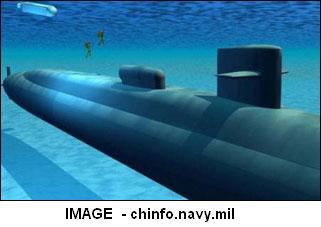Analyst Frothing About "SSUN"s or Are Submarine Developments Brewing?
 WASHINGTON, D.C.: Analyst stresses importance of UUV to US maritime supremacy -From Jane's Information Group (Abstract): Robert Work, senior US analyst from the Center for Strategic and Budgetary Assessments (CSBA) argued that instead of building diesel submarines as the Chinese are, the US would do better to invest in technologies its potential opponents are not. At the moment, it is more important to protect the design base than the industrial base. "The US ought to be making bold moves so that in 15 years from now the country can upset the money the Chinese have been ploughing into their [conventional] programmes," said Work.
WASHINGTON, D.C.: Analyst stresses importance of UUV to US maritime supremacy -From Jane's Information Group (Abstract): Robert Work, senior US analyst from the Center for Strategic and Budgetary Assessments (CSBA) argued that instead of building diesel submarines as the Chinese are, the US would do better to invest in technologies its potential opponents are not. At the moment, it is more important to protect the design base than the industrial base. "The US ought to be making bold moves so that in 15 years from now the country can upset the money the Chinese have been ploughing into their [conventional] programmes," said Work.Mr. Work contends that a wise approach toward maritime supremacy would place more emphasis on UUVs and small manned submarines, such as the French concept of a mother submarine taking two smaller manned submarines into an area of operations. (emphasis added)
What could this U.S. analyst (an ex 27-year Marine Corps officer who held a range of command and leadership positions and also earned advanced degrees from the US Naval Postgraduate School, the University of Southern California, and Johns Hopkins University) be hinting about future investments? Here are a few possibilities:
-1a- From CSBA draft: "...FPMs (ed. Flexible Payload Modules) may effectively convert the SSGN to a 'SSUN:' a covert UUV tender capable of operating and controlling swarms of UUVs in a contested littoral (ed. battle)"
-1b- From New Mexico State University: RioRoboLab, is working to develop tiny robotic submarines that imitate swarm behavior and intelligence. Swarm intelligence and behavior are exhibited naturally by ant colonies, bees, flocks of birds, herds of wild animals on an African safari and a multitude of biological systems including schools of fish, according to graduate student Matthew King. Groton submariners may remember the schools of untold thousands of tiny fish completely encircling the hull of your pierside vessels. In an instant the direction of all the fish would change inexplicably from CCW to CW or vice versa. "Small, radio-controlled submarines will be placed inside of a large fish tank to mimic a school of fish. The submarines should be able to move in a coordinated fashion inside the fish tank without running into each other or the walls of the tank," King said.
-2- From September 2005 (Molten Eagle) here: The not so obvious advantage of reduced force size (with U.S. submarines of significantly greater flexibility and endurance) is added stealth. That could be tremendous to forward positioning in areas such as the South China Sea. It will require a radically different playing of today's submarine "shell game." Subs could eventually be deployed much longer (over a year?), rotating smaller crews and provisioning as necessary via a submerged tender (mother sub in each theatre) while SUBMERGED. Yes, it may be more practical for DSRV-type subs to ferry between the mother sub and the patrolling SSN/GN/XN.
Submarines, always silent and strange.











